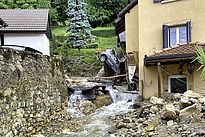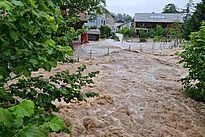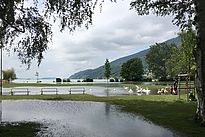07.06.2022 | Käthi Liechti | News WSL | News SLF
In 2021, floods, landslides, debris flows, rockfalls and rockslides caused some CHF 450 million of damage across Switzerland, the highest amount since 2007. The bulk of the costs resulted from flooding in June and July, with these summer months seeing extremely stormy and wet weather. These were the conclusions of the annual analysis of the Swiss flood and landslide damage database kept by the Federal Institute for Forest, Snow and Landscape Research (WSL).
The wet and stormy summer of 2021 had a clear impact on the costs of damage caused by floods and landslides. For the first time since 2007, these costs rose significantly above CHF 300 million, the inflation-adjusted average for the years 1972 to 2020, ranking ninth highest in the 50-year observation series. By far the largest share of damage costs (97%) resulted from flooding due to overflowing bodies of water and overland flow in June and July. Flooding also caused one death, in the canton of Basel-Landschaft.

Many floods due to thunderstorms and continuous rain
Summer 2021 saw an unusually high number of storms occurring in rapid succession. Between Lake Geneva and Lake Constance, only a few places escaped being hit by one of the many thunderstorms that swept through in June and July. As such, the large number of widespread damage events was the primary reason for the above-average costs, not individual and localised severe events (which was the case in other years that saw similarly high costs).
In 2021, the greatest damage caused by thunderstorm-related flooding occurred in Cressier (canton of Neuchâtel) on 22 June, in the Bernese Jura and the districts of Waldenburg and Sissach in Basel-Landschaft on 23 June, in Vordemwald in Aargau on 24 June and in the district of March in Schwyz on 25 July. From mid-July onwards, constant rainfall caused many lakes and rivers to rise above the high-water marks, resulting in considerable damage, especially in the communities bordering the lakes at the feet of the Jura. In Ticino, thunderstorms and persistent rain led to flooding as streams burst their banks, especially in late July and early August. The mountain cantons of Valais and Grisons mostly escaped such damage in 2021. WSL analyses do not take into account hail and storm damage, which was substantial in some regions in 2021.

The Swiss Federal Institute for Forest, Snow and Landscape Research (WSL) has been systematically collecting information on flood and landslide damage since 1972. The database, created with the support of the Federal Office for the Environment (FOEN), contains data on damage caused by floods, debris flows and landslides and, since 2002, rockfalls, rock slides and rock avalanches. Damage caused by avalanches, snow pressure, earthquakes, lightning strikes, hail and gales is not taken into account. Estimates of property, infrastructure, forest and agricultural damage are based primarily on media reports. The data are available to experts upon request and constitute an important basis for risk assessment. The FOEN uses the WSL survey on flood and landslide damage for its environmental reporting.
Always up to date: Subscribe to WSL Newsletter
Contact
Links and documents
Copyright
WSL and SLF provide the artwork for imaging of press articles relating to this media release for free. Transferring and saving the images in image databases and saving of images by third parties is not allowed.



